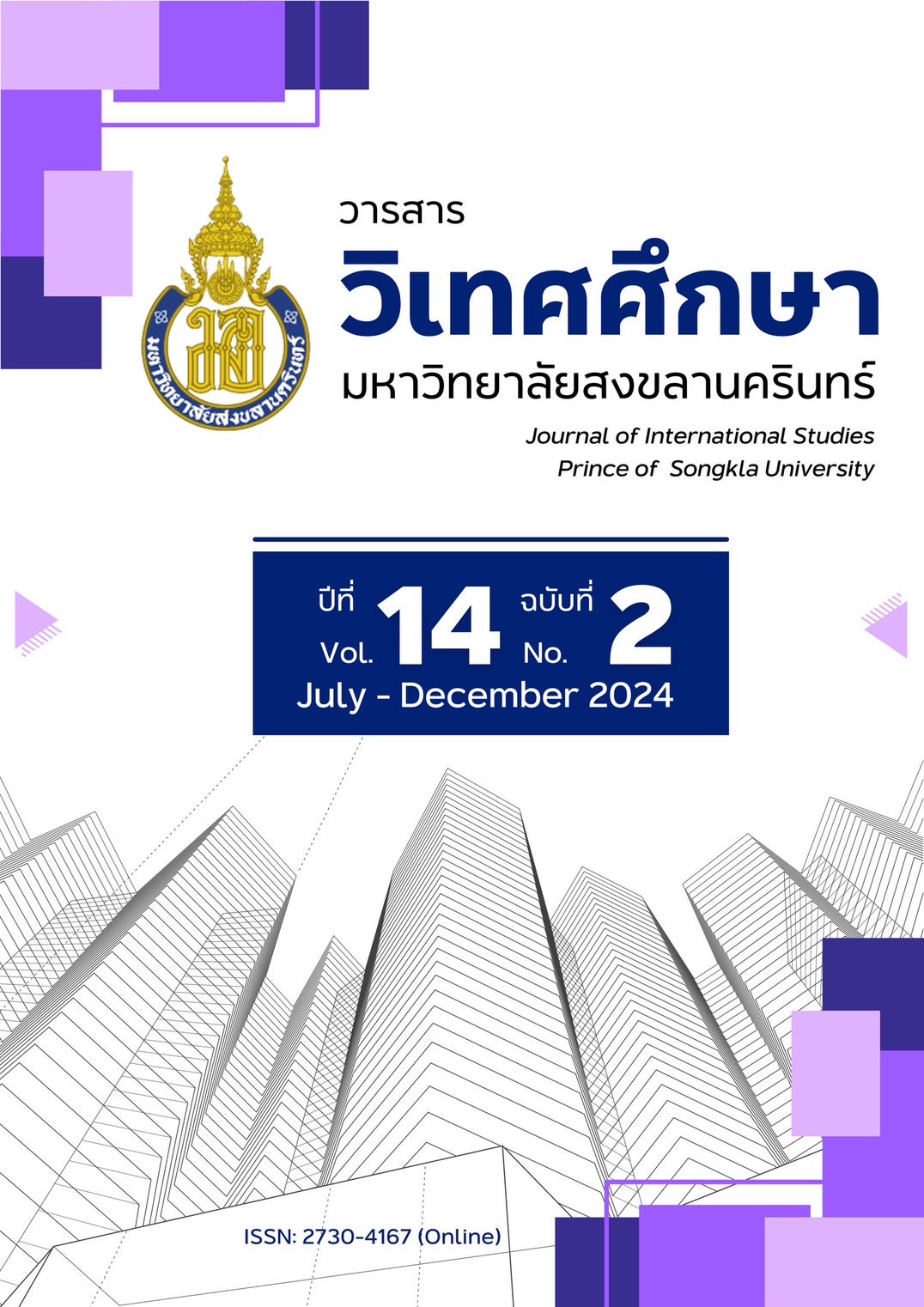The Structural Influence of Quality and Value Affecting Brand Loyalty in Chiang Rai Brands, Chiang Rai Province
Main Article Content
Abstract
The purpose of this study is aim to develop and verify the consistency of a structural equation model examining how quality and value affect brand loyalty for the Chiang Rai Brand in Chiang Rai Province. Data was gathered from 400 customers of Chiang Rai Brand products using purposive sampling. Questionnaires were employed to collect the data, which was then analyzed using statistical software to obtain basic statistical results and confirm the model through structural equation modeling (SEM).
The study found that the developed structural equation model of quality and value affecting brand loyalty in the Chiang Rai Brand was consistent with the empirical data and demonstrated a good fit. Product quality and product value factors affected brand loyalty in Chiang Rai Brand products with factor loadings of 0.95 and 0.62, respectively.
For product quality variables, ease of use had the highest effect on loyalty, followed by meeting customers' minimum requirements of customers, and standards certification, with factor loadings of 0.94, 0.80, and 0.69, respectively.
Regarding product value variables, the monetary value of Chiang Rai Brand products had the greatest impact on loyalty, followed by emotional value, and social value. The corresponding factor loadings were 0.97, 0.92, and 0.61, respectively.
Article Details

This work is licensed under a Creative Commons Attribution-NonCommercial-NoDerivatives 4.0 International License.
Statements and opinions expressed in articles herein are those of the authors and do not necessarily reflect the position of the editors or publisher.
Article, information, text, image, etc. which are published in Journal of International Studies, belong to Journal of International Studies. If anybody or any organization would like to use part or whole of them, they must receive written permission from Journal of International Studies before usage.
References
กัญจพร วงศ์ศิริสิน. (2559). คุณค่าของผลิตภัณฑ์ที่ส่งผลต่อการตัดสินใจซื้ออาหารสุนัข Natural & Premium แบรนด์ V CARE U ของผู้บริโภคในเขตกรุงเทพมหานคร. (สารนิพนธ์ ปริญญาบริหารธุรกิจมหาบัณฑิต). กรุงเทพฯ: มหาวิทยาลัยกรุงเทพ. http://dspace.bu.ac.th/jspui/handle/123456789/2069
กัลยา วานิชย์บัญชา. (2549). สถิติสำหรับงานวิจัย (พิมพ์ครั้งที่ 2). สำนักงานพิมพ์จุฬาลงกรณ์มหาวิทยาลัย.
เกตุวดี สมบูรณ์ทวี คมกริช ศรีไพรงาม และ ลลิตภัทร สร้างถิ่น. (2561). ปัจจัยด้านคุณภาพที่ส่งผลต่อการตัดสินใจซื้อรถยนต์สัญชาติญี่ปุ่น. วารสารการจัดการ มหาวิทยาลัยวลัยลักษณ์, 7(1), 1-8. https://so06.tci-thaijo.org/index.php/wms/article/view/110390
จีรนุช ศิริมงคล. (2565). การรับรู้คุณค่าและความภกั ดีต่อตราสินคาพ้อดแคสตข์องผบู้ริโภคเจนเนอเรชั่นวาย: การตรวจสอบ
ความตรงเชิงโครงสร้างและการศึกษาความสัมพันธ์. (วิทยานิพนธ์ ปริญญาบริหารธุรกิจมหาบัณฑิต). กรุงเทพฯ: มหาวิทยาลัยบูรพา. https://buuir.buu.ac.th/bitstream/1234567890/5442/1/62920341.pdf
ณัฐฌา เสรีวัฒนา. (2560). ภาพลักษณ์ตราสินค้า คุณภาพการบริการและคุณค่าตราสินค้าที่มีอิทธิพลต่อความภักดีและการตัดสินซื้อผลิตภัณฑ์ร้านไทย-เดนมาร์ค มิลค์แลนด์ของผู้บริโภคในเขตกรุงเทพมหานคร. (ปริญญานิพนธ์ ปริญญาบริหารธุรกิจมหาบัณฑิต). กรุงเทพฯ: มหาวิทยาลัยศรีนครินทรวิโรฒ. http://ir-ithesis.swu.ac.th/dspace/bitstream/123456789/979/1/gs611110143.pdf
พิเชษฐ เนตรสว่าง. (2564). การจัดการคุณภาพมาตรฐานสินค้าและบริการในยุคปัจจุบัน. วารสารวิทยาการจัดการปริทัศน์, 23(2), 267-280. https://so03.tci-thaijo.org/index.php/msaru/article/view/253537
วัลย์ลิกา จาตุประยุร. (2559 ปริญญาบริหารธุรกิจมหาบัณฑิต). กรุงเทพฯ: มหาวิทยาลัยเทคโนโลยีราชมงคลรัตนโกสินทร์.
สมสุณีย์ ดวงแข. (2563). ปัจจัยที่มีอิทธิพลต่อความยั่งยืนในความภักดีของลูกค้าธุรกิจบริการสุขภาพผู้สูงอายุในประเทศไทย. (วิทยานิพนธ์ บริหารธุรกิจดุษฎีบัณฑิต). กรุงเทพฯ: มหาวิทยาลัยเทคโนโลยีธุรกิจบัณฑิตย์.
https://libdoc.dpu.ac.th/thesis/Somsunee.Dua.pdf
สุธีมนต์ ทรงศิริโรจน์, ภาคภูมิ ภัควิภาส และรัฐนันท์ พงศ์วิริทธิ์ธร. (2560). ปัจจัยที่ส่งผลต่อความจงรักภักดีของผู้บริโภค: บทบาทของเอกลักษณ์และคุณค่าตรา “เชียงใหม่แบรนด์”. วารสารราชมงคลล้านนา, 5(1), 72-81.
อารุณี วงค์พุ่ม. (2559). การรับรู้คุณค่าและส่วนประสมทางการตลาดที่มีอิทธิพลต่อพฤติกรรมการซื้อผลิตภัณฑ์เสริมอาหารของผู้บริโภคในอำเภอ เมืองลำปาง จังหวัดลำปาง. วารสารบัณฑิตศึกษา มหาวิทยาลัยราชภัฏสกลนคร, 13(60), 213-224.
https://so02.tci-thaijo.org/index.php/SNGSJ/article/view/65873
Aaker, D. A. (1991). Managing brand equity: Capitalizing on the value of a brand name.
Anderson, J. C., & Gerbing, D. W. (1988). Structural equation modeling in practice: A review and recommended two-step approach. Psychological Bulletin. 103(3), 411-423. https://doi.org/10.1037/0033-2909.103.3.411
Butz, J. H. E., & Goodstein, L. (1996). Measuring customer value: Gaining the strategic advantage. Organizational Dynamics, 24(3), 63-77. https://doi.org/10.1016/S0090-2616(96)90006-6
Cochran, W.G. (1953). Sampling Techniques. New York : John Wiley & Sons.
Crosby. (1979). Three Experts on Quality Management ,TQLO Publication Research. July 1992, 92-02. https://apps.dtic.mil/sti/tr/pdf/ADA256399.pdf
Gomez, B. G., Arranz, A. G., & Cillan, J. G. (2006). The role of loyalty programs in behavioral and affective loyalty. Journal of Consumer Marketing, 23(7), 387–396. DOI:10.1108/07363760610712920
Hair, J. F., Jr., Black, W. C., Babin, B. J., Anderson, R. E., & Tatham, R. L. (2006). Multivariate data analysis (6ed.). Upper Saddle River, New Jersey: Prentice Hall. New York, NY: Free Press. of a Multiple Item Scale. https://www.drnishikantjha.com/papersCollection/Multivariate%20Data%20Analysis.pdf
Solomon, M. R. (1996). Consumer behavior: Buying, having, and being (3rd ed.). N J Eaglewood Cliffs: Prentice Hall
Sweeney, J. C., & Soutar, G. N. (2001). Consumer-Perceived Value: The Development
Wang, S.T. E. (2013). The influence of visual packaging design on perceived food product quality, value, and brand preference. International Journal of Retail & Distribution Management, 41(10), 805-816.


